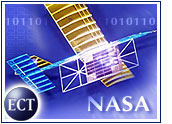
By soaking up laser light and converting it to electricity to power its propeller, a model airplane maintained flight as a team of NASA researchers used the light to power the craft from the ground.
Officials at NASA’s Marshall and Dryden flight centers, as well as the University of Alabama in Huntsville, report the flight is the first use of laser light energy to power a plane. The technology could lead to breakthroughs in remote sensing, such as weather observation, and in telecommunications, where floating transmitters could relay data.
“A telecommunications company could put transponders on an airplane and fly it over a city,” said David Bushman, project manager for beamed power at NASA’s Dryden Flight Research Center in Edwards, California. “The aircraft could be used for everything from relaying cell phone calls to cable television or Internet connections.”
Flight by Light
NASA researchers, who made a series of similar demonstration flights last year using a spotlight demonstration, believe they have accomplished the first successful flight of an airplane powered entirely by remote laser.
NASA spokesperson Jerry Berg told TechNewsWorld that there has been interest in beaming power to aircraft for more than 30 years, referring to late 1960s research on the use of microwave energy to power positioned helicopters.
However, the latest demonstration involved, for the first time, photovoltaic cells on the aircraft — which had a five-foot wingspan and weighed 11 ounces — and an invisible, ground-based laser beam that tracked the plane in flight.
Indefinite Airtime
Using the laser-fueled flight method, a craft could remain flying as long as the energy source was uninterrupted, according to NASA Marshall Space Flight Center project manager Robert Burdine, who called the test flight “a groundbreaking development for aviation.”
Researchers, who indicated multiple laser sources could be used to prevent interruptions and distribute power needs, said the demonstration flight was a key step toward the capability to beam power to a plane aloft.
“Without the need for onboard fuel or batteries, such a plane could carry scientific or communication equipment, for instance, and stay in flight indefinitely,” said a NASA statement.
Lasers for Fuel
Other efforts to harness laser light for power include a U.S. defense experiment three years ago that fired a grapefruit-size projectile using a laser, and a Japanese effort in 2002 that used a laser (in addition to evaporation) to fuel a small paper airplane.
Laser light also has been the theoretical basis for powering tiny microelectromechanical systems (MEMS) by spinning carbon nanotubes. That work, under way by researchers at the Weizmann Science Institute in Rehovot, Israel, builds on the previous design of a laser-powered nanomotor at Oak Ridge National Laboratory in Tennessee.
A representative of NASA’s Dryden Flight Research Center told TechNewsWorld that although this technology is in its infancy, similar efforts in solar-powered flight have drawn substantial investment from industry, particularly in Japan.
Beaming and Streaming
Berg said there are several situations, including weather monitoring and telecommunications, in which an airborne platform closer to Earth than a satellite offers advantages.
“This may be a way of keeping something up there for a long period of time, for little cost, and having the ability to bring it back down when it needs maintenance,” Berg said.
Researchers with NASA, which says laser-power beaming promises to revolutionize aircraft design and operation, indicated that flying relay stations could make it cheaper for telephone, wireless, Internet and other telecommunications carriers to maintain advanced networks.











































